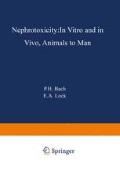Abstract
The antitumour drug Celiptium (N2-methyl-9-hydroxyellipticinium) is an ellipticine derivative, effective in experimental tumours (1) and in man. Celiptium is metabolized in liver and excreted by the biliary tract (60%) and urine (30%). However, a renal metabolism occurs in both rats and humans treated with Celiptium, cysteine and N-acetylcysteine conjugates appear in the urine (2). Moreover, it was shown that isolated rat kidney cells metabolize Celiptium into the same conjugates which were found in rat or human urines whereas these compounds were not detected in bile (3).
Access this chapter
Tax calculation will be finalised at checkout
Purchases are for personal use only
Preview
Unable to display preview. Download preview PDF.
References
C. Paoletti, J.B. Le Pecq, N. Dat Xuong, P. Juret, H. Garnier, J.L. Amiel, J. Rouesse, Antitumor activity, pharmacology and toxicity of ellipticines, ellipticinium and 9-hydroxy-derivatives: preliminary clinical trials of 2-methyl-9-hydroxy-ellipticinium (NSC-264–137). Recent Results Canc. Res., 74:107 (1980)
B. Monsarrat, M. Maftouh, G. Meunier, B. Dugue, J. Bernadou, J.P. Armand, C. Picard-Fraire, B. Meunier, C. Paoletti, Human and rat urinary metabolites of the hydroxy methylellipticinium. Identification of cysteine conjugates supporting the bioxidative alkylation hypothesis. Biochem. Pharmacol., 32:3887 (1983)
M. Maftouh, Y. Amiar, C. Picard-Fraire. Metabolism of the antitumor drug N2-methyl-9-hydroxyellipticinium acetate in isolated rat kidney cells. Biochem. Pharmacol., 34:427 (1985)
P. Juret, A. Tanguy, A. Girard. L’ acitate d’ hydroxy-9-mithyl-2-ellipticinium. Etude toxicologique et thirapeutique chaz 100 cancereux. Nouv. Presse Med. 8:1494 (1978)
G. Raguinez-Viotte, C. Dadoun, P. Buchet, T. Ducastelle, J.P. Fillastre. Renal toxicity of the antitumor drug N2-methyl-9-hydroxy-ellipticinium acetate in the Wistar rat. Submitted Arch Toxicology.
O.B. Bayliss-High, Lipids In: Theory and practice of histological techniques, Bancroft, edited by J. D. Stevens, Melbourne-New York. p.217 (1982)
O. H. Lowry, N.J. Rosebrough, A.L. Farr, R.J. Randall, Protein measurement with the Folin phenol reagent. J. Biol. Chem. 193:265 (1951)
E.G. Bligh and W.J. Dyer. A rapid method of total lipid extraction and purification. Can. J. Biochem. Physiol. 37:911 (1959)
J.A. Buege and S.D. Aust, Microsomal lipid peroxidation. Methods Enzymol. 52:302 (1978)
H. Ohkawa, N. Ohishi, K. Yagi, Assay for lipid peroxides in animal tissues by thiobarbituric acid reaction. Anal. Biochem. 95:351 (1979)
V.P. Skipski, R.F. Peterson, M. Barclay, Quantitative analysis of phospholipids by thin layer chromatography. Biochem. J. 90:374 (1964)
G.R. Bartlett, Phosphorus assay in column chromatography. J. Biol. Chem. 234:466 (1959)
W.R. Morrison and L.M. Smith, Preparation of fatty acid methyl esters and dimethylacetals from lipids with boron trifluoride-methanol. J. Lipid Res. 5:600 (1964)
A.L. Tappel, Lipid peroxidation damage to cell components. Fed. Proc. 32:1870 (1973)
H. Kappus, Lipid peroxidation: mechanisms, analysis, enzymology and biological relevance. In: “Oxidative stress” edited by H. Sies, Academic Press. p. 273 (1985)
C. Auclair, K. Hyland and C. Paoletti. Autooxidation of the antitumor drug 9-hydroxyellipticine and its derivatives. J. Med. Chem. 26:1438 (1983)
Author information
Authors and Affiliations
Editor information
Editors and Affiliations
Rights and permissions
Copyright information
© 1989 Springer Science+Business Media New York
About this chapter
Cite this chapter
Raguenez-Viotte, G., Dadoun, C., Van den Bossche, A.M., Fillastre, J.P. (1989). Celiptium Induced Lipid Peroxidation and Toxicity in Rat Renal Cortex. In: Bach, P.H., Lock, E.A. (eds) Nephrotoxicity. Springer, Boston, MA. https://doi.org/10.1007/978-1-4757-2040-2_68
Download citation
DOI: https://doi.org/10.1007/978-1-4757-2040-2_68
Publisher Name: Springer, Boston, MA
Print ISBN: 978-1-4757-2042-6
Online ISBN: 978-1-4757-2040-2
eBook Packages: Springer Book Archive

